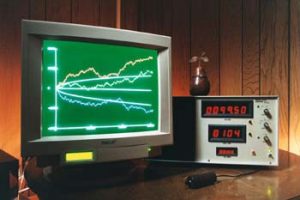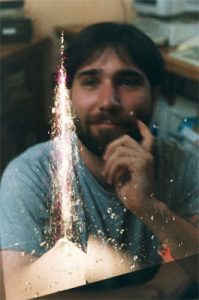The PEAR Laboratory - An Overview
The Princeton Engineering Anomalies Research (PEAR) program flourished for nearly three decades (1979-2007) under the aegis of Princeton University’s School of Engineering and Applied Science where it completed its experimental agenda of studies in two main areas: 1) the interaction of human consciousness with sensitive physical devices, systems, and processes, and 2) the mechanisms and processes of human perception through non-traditional sensing, i.e. remote perception not associated with the traditional five senses. PEAR built upon these scientific investigations in developing complementary theoretical models to enable better understanding of the role of consciousness in the establishment of physical reality.
On this page you will find first an introduction to the various experiments used in the PEAR Laboratory. For each one, there is a very short written description whose purpose is to perhaps interest you enough to learn a little more by watching the associated video. You can also get a much richer description of the PEAR Laboratory and the work done there with The PEAR Proposition materials, or even see an archive of the original PEAR website. Although the equipment is no longer being used to collected additional data for scientific data collection or analysis, much of it – and even some of PEAR’s furniture and decorations – is currently on loan to an organization called the Wyrd Experience, located in Yorkshire, UK, where you can see it all in person.
Further down the page is a brief overview of some of the key findings of the PEAR program. Note, however, that this page is still under construction, so you may wish to bookmark it for a later revisit as more content is being added regularly (you will need to log in to your account first in order to access the bookmarking function).
The PEAR Laboratory Itself
 Prior to getting to the different equipment and experiments, it is important to recognize that the feeling of the PEAR lab was itself an important component. Unlike too many science and engineering spaces that treat visitors like obstacles or intrusions, when a person visited PEAR, they were a welcomed guest. While the work was serious, the physical space was cozy and comfortable, decorated with no small share of whimsy, and this was an essential element. In any program studying consciousness effects, which is driven by fundamentally subjective factors, it is essential to recognize that the internal state of a person will be particularly important.
Prior to getting to the different equipment and experiments, it is important to recognize that the feeling of the PEAR lab was itself an important component. Unlike too many science and engineering spaces that treat visitors like obstacles or intrusions, when a person visited PEAR, they were a welcomed guest. While the work was serious, the physical space was cozy and comfortable, decorated with no small share of whimsy, and this was an essential element. In any program studying consciousness effects, which is driven by fundamentally subjective factors, it is essential to recognize that the internal state of a person will be particularly important.
The Random Mechanical Cascade, A.K.A. Murphy
 Certainly the most iconic experiment in the PEAR laboratory was the Random Mechanical Cascade, which occupied the entirety of one wall in the main room. This device comprised a set of 9000 ceramic balls that would fall through a matrix of pins, each bouncing about to land in one of 19 bins, ultimately forming a Gaussian “bell-shaped” distribution. An operator would sit in front of the machine and maintain an intention for the balls to go to one side or the other in order to sway the resulting distribution. Runs were done in threes: one with an intention to go left, another to go right, and a third with no intention at all (called a baseline). After each, a photograph of the distribution was taken to document the counts (which were shown with red LEDs under each bin), but the data was also saved in a computer file for analysis. Each sequence of three runs would take about a half an hour.
Certainly the most iconic experiment in the PEAR laboratory was the Random Mechanical Cascade, which occupied the entirety of one wall in the main room. This device comprised a set of 9000 ceramic balls that would fall through a matrix of pins, each bouncing about to land in one of 19 bins, ultimately forming a Gaussian “bell-shaped” distribution. An operator would sit in front of the machine and maintain an intention for the balls to go to one side or the other in order to sway the resulting distribution. Runs were done in threes: one with an intention to go left, another to go right, and a third with no intention at all (called a baseline). After each, a photograph of the distribution was taken to document the counts (which were shown with red LEDs under each bin), but the data was also saved in a computer file for analysis. Each sequence of three runs would take about a half an hour.
The device was given the name Murphy during its construction in testament to the way that it came to personify the idea of Murphy’s Law. Everything that could possibly go wrong invariably did, from jamming of the feeding slot at the top and the counting devices on the bins to the freezing of the belt that carried the marbles up to the top, and so many, many more challenges – a majority of which generally ended with the PEAR staff picking up thousands of balls off the floor and putting them back into the machine.
The Random Event Generator (REG)
 While Murphy easily had the most dynamic presence in the lab, the Random Event Generator (REG) was the workhorse of the PEAR experiments. Trials ran faster (and much more quietly) than with the RMC, and data collection was greatly simplified, but the essence of the experiment was the same. Data was collected in sets of three – a baseline where the operator did not try to influence the device, one where they would try to get higher numbers, and one where the intention was for lower numbers.
While Murphy easily had the most dynamic presence in the lab, the Random Event Generator (REG) was the workhorse of the PEAR experiments. Trials ran faster (and much more quietly) than with the RMC, and data collection was greatly simplified, but the essence of the experiment was the same. Data was collected in sets of three – a baseline where the operator did not try to influence the device, one where they would try to get higher numbers, and one where the intention was for lower numbers.
The numbers shown to the operator were the summation of 200 individual events, each producing either a 1 or a 0 with (under uninfluenced operations) 50/50 odds either way. Consequently, the numbers displayed to the operator varied around 100 (e.g. perhaps a sequence like 97, 108, 102, 99, 84, 101, 111, etc.). These were updated every second until the trial was completed. The cumulative sum of these numbers (technically the numbers minus the average value of 100) over the course of a run produced the cumulative deviation plot that has become the “go to” graphical representation of such experiments.
Over the years, REGs became smaller and eventually portable, giving rise to the FieldREG experiments where measurements were taken at venues such as sports events and musical performances, and ultimately leading to the Global Consciousness Project that was initiated and run for many years by PEAR’s Roger Nelson.
The Drum
 A natural question in research on how consciousness influences reality is the role of the specific forms of that reality. Does watching numbers on a digital display versus something more physical, more material, or even something non-visually based, make a difference? The Drum experiment provided an investigation into these questions.
A natural question in research on how consciousness influences reality is the role of the specific forms of that reality. Does watching numbers on a digital display versus something more physical, more material, or even something non-visually based, make a difference? The Drum experiment provided an investigation into these questions.
This experiment used the same REG technology to drive a drum with varying intensities of beats or different frequencies of beats, and again asking operators to influence those factors through conscious intention. The Native American drum, shown in the picture, has a deep, resonant quality (you can hear it in the video), and consequently the experiment itself presented a very ‘indigenous exploration’ feel.
The Pendulum
 Unlike the Drum experiment, which leveraged REG technology, the Pendulum experiment (like the RMC) looked at yet another modality of physical phenomena. Here the question was whether one could influence the damping of a swinging pendulum, resulting in a change in the length of time it took to come to rest. A mechanical arm would displace the bob of the pendulum to a set, consistent displacement, and then release it to swing. Sensitive electronics were used to measure the period (and velocity at the center of the swing), but the affected aspect of the system was the damping itself. As with all experiments – those covered on this page, as well as other modalities that were explored, such as acoustics, optics, thermal effects, etc. – the results of the pendulum experiment showed the same kinds of patterns as all the rest, suggesting that what is most important in these phenomena are not the specific physics of the systems, but the interaction of consciousness and intention with the uncertainty that underlies the system itself.
Unlike the Drum experiment, which leveraged REG technology, the Pendulum experiment (like the RMC) looked at yet another modality of physical phenomena. Here the question was whether one could influence the damping of a swinging pendulum, resulting in a change in the length of time it took to come to rest. A mechanical arm would displace the bob of the pendulum to a set, consistent displacement, and then release it to swing. Sensitive electronics were used to measure the period (and velocity at the center of the swing), but the affected aspect of the system was the damping itself. As with all experiments – those covered on this page, as well as other modalities that were explored, such as acoustics, optics, thermal effects, etc. – the results of the pendulum experiment showed the same kinds of patterns as all the rest, suggesting that what is most important in these phenomena are not the specific physics of the systems, but the interaction of consciousness and intention with the uncertainty that underlies the system itself.
One of the hypotheses that drove the creation of this apparatus was the potential for people to resonate with the crystal bob that was used. Interestingly, the results of operators interacting with the Pendulum experiment remotely was actually slightly stronger than those who were sitting right in front of it, and so if there is such a relationship, it is clearly not a straightforward one.
The Fountain
 Another example of an apparatus designed to resonate with human nature was the Fountain. In this experiment, operators would interact at the intention level with an upward-shooting jet of water, attempting to vary its behavior, either be causing it to rise higher or lower, or to change where it transitioned from laminar to turbulent flow. As with the Pendulum (and, in fact, all of the experiments), the results were consistent – small effects that held strong significance when taken in aggregate. Once again, the message was essentially the same: our intentions are capable of influencing the behavior of random systems regardless of the nature of the system itself, and the most important elements that determine the strength and nature of that influence are the subjective ones associated with consciousness.
Another example of an apparatus designed to resonate with human nature was the Fountain. In this experiment, operators would interact at the intention level with an upward-shooting jet of water, attempting to vary its behavior, either be causing it to rise higher or lower, or to change where it transitioned from laminar to turbulent flow. As with the Pendulum (and, in fact, all of the experiments), the results were consistent – small effects that held strong significance when taken in aggregate. Once again, the message was essentially the same: our intentions are capable of influencing the behavior of random systems regardless of the nature of the system itself, and the most important elements that determine the strength and nature of that influence are the subjective ones associated with consciousness.
The Robot
 The last experiment that we will present here (at least for now) was partly inspired by a study by a researcher named René Peoc’h in which a group of chicks imprinted on a robot that moved in response to random signals. After a few days, they noticed that the robot was spending a disproportionate amount of time near the chicks, something that should not have happened given its design to move randomly.
The last experiment that we will present here (at least for now) was partly inspired by a study by a researcher named René Peoc’h in which a group of chicks imprinted on a robot that moved in response to random signals. After a few days, they noticed that the robot was spending a disproportionate amount of time near the chicks, something that should not have happened given its design to move randomly.
In the Robot experiment, the very first PEAR frog would ride around on a small robot car that was controlled – in terms of turns and forward motion – by an REG, and operators would attempt to influence the behavior of the vehicle, such as making it approach them, to spend more time on the circular table before hitting an edge, etc. This experiment was a particular favorite of the children in school classes that would visit the lab, and often the table was surrounded by children, each of whom would try to make the robot come to them instead of someone else.
Data was collected via a camera mounted above the table tracking a light on the top of the “car”, thereby allowing assessments of the randomness (or more to the point, deviations from randomness) of its path.


 degree from Hollis University and has accumulated a diverse work experience, spanning multiple disciplines: education, technology, business and law, predominately in support and administrative roles. She currently works for the College of New Jersey in its Office of Disability Support Services. Lynn Ann has been an administrative assistant to ICRL’s President since 2011, and has extensive familiarity with the organization’s structure and activities, along with a deep commitment to its mission.
degree from Hollis University and has accumulated a diverse work experience, spanning multiple disciplines: education, technology, business and law, predominately in support and administrative roles. She currently works for the College of New Jersey in its Office of Disability Support Services. Lynn Ann has been an administrative assistant to ICRL’s President since 2011, and has extensive familiarity with the organization’s structure and activities, along with a deep commitment to its mission.
 Vasileios Basios is a physicist, conducting interdisciplinary research on the foundations of complexity science and nonlinear systems, self-organization and complex matter. During his formative years, he was tutored by Ilya Prigogine, at ULB where he received his PhD, and by Emilios Bouratinos on meditation and philosophy. He is currently interested in the complex interface between action and information. Other interests include the history of ideas in science and their role in the transformation of science beyond the prevailing naïve, materialistic, mechanistic-reductionist world-view. With others from PEAR, he initiated the Mind-Matter-Mapping Project and has since published several essays for ICRL. He is also a member of the Board of the Scientific and Medical Network and the Steering Team of the Galileo Commission. Vasileios is inspired by the prospect of introducing self-reflection into the practice and understanding of science, and the emergence of a Self-Reflexive Science of Consciousness.
Vasileios Basios is a physicist, conducting interdisciplinary research on the foundations of complexity science and nonlinear systems, self-organization and complex matter. During his formative years, he was tutored by Ilya Prigogine, at ULB where he received his PhD, and by Emilios Bouratinos on meditation and philosophy. He is currently interested in the complex interface between action and information. Other interests include the history of ideas in science and their role in the transformation of science beyond the prevailing naïve, materialistic, mechanistic-reductionist world-view. With others from PEAR, he initiated the Mind-Matter-Mapping Project and has since published several essays for ICRL. He is also a member of the Board of the Scientific and Medical Network and the Steering Team of the Galileo Commission. Vasileios is inspired by the prospect of introducing self-reflection into the practice and understanding of science, and the emergence of a Self-Reflexive Science of Consciousness.
 Ian Cook is a Professor of Psychiatry and Biobehavioral Sciences at the David Geffen School of Medicine at UCLA, where he directs the UCLA Depression Research and Clinic Program at the Semel Institute and was the inaugural holder of the Joanne and George Miller and Family Endowed Chair in Depression Research at the Brain Research Institute. He has been a part of the PEAR/ICRL family since 1980, when he was among the first undergraduate students to conduct research at the PEAR lab. He graduated from the Yale School of Medicine and pursued his residency training and research fellowship at UCLA. His research has focused on understanding the relationships among the mind, the brain, and the body, and in translating developments in technology into more effective treatments for disorders of mood and cognition.
Ian Cook is a Professor of Psychiatry and Biobehavioral Sciences at the David Geffen School of Medicine at UCLA, where he directs the UCLA Depression Research and Clinic Program at the Semel Institute and was the inaugural holder of the Joanne and George Miller and Family Endowed Chair in Depression Research at the Brain Research Institute. He has been a part of the PEAR/ICRL family since 1980, when he was among the first undergraduate students to conduct research at the PEAR lab. He graduated from the Yale School of Medicine and pursued his residency training and research fellowship at UCLA. His research has focused on understanding the relationships among the mind, the brain, and the body, and in translating developments in technology into more effective treatments for disorders of mood and cognition.
 Bob (Brahmatirtha) was born in Newark, New Jersey, in 1949, completed his B.S. in Chemistry at Rensselaer Polytechnic Institute in 1971, and received his M.S. in Geology from Rutgers University in 1975. After a twenty-year career serving as a geologist and vice-president of a large regional environmental company, he currently works as an environmental consultant to state governments. He has been a member of the Bhaktivedanta Institute since the inception in 1976, giving a presentation at their First International Conference on Life Comes from Life in 1977, and working on a multitude of projects with R.L. Thompson (Sadaputa) from 1995 through 2008. He is also a certified court mediator. He now serves as the Director of the Bhaktivedanta Institute for Higher Studies.
Bob (Brahmatirtha) was born in Newark, New Jersey, in 1949, completed his B.S. in Chemistry at Rensselaer Polytechnic Institute in 1971, and received his M.S. in Geology from Rutgers University in 1975. After a twenty-year career serving as a geologist and vice-president of a large regional environmental company, he currently works as an environmental consultant to state governments. He has been a member of the Bhaktivedanta Institute since the inception in 1976, giving a presentation at their First International Conference on Life Comes from Life in 1977, and working on a multitude of projects with R.L. Thompson (Sadaputa) from 1995 through 2008. He is also a certified court mediator. He now serves as the Director of the Bhaktivedanta Institute for Higher Studies.
 Carolyn is a writer and dancer, two avenues that support her central purpose as a healer. Through her numerous books she teaches that every moment brings unbidden opportunities from the universe, that every day of is filled with beauty and surprise. Ecstatic experience is the goal of her work, the personal to the cosmic.
Carolyn is a writer and dancer, two avenues that support her central purpose as a healer. Through her numerous books she teaches that every moment brings unbidden opportunities from the universe, that every day of is filled with beauty and surprise. Ecstatic experience is the goal of her work, the personal to the cosmic. 
 The largest dataset collected at PEAR used Random Event Generators, or REGs. These devices were essentially electronic coin flippers that produced a series of 1’s and 0’s; operators were instructed to influence the machines to produce more 1’s than 0’s or vice versa.
The largest dataset collected at PEAR used Random Event Generators, or REGs. These devices were essentially electronic coin flippers that produced a series of 1’s and 0’s; operators were instructed to influence the machines to produce more 1’s than 0’s or vice versa.

